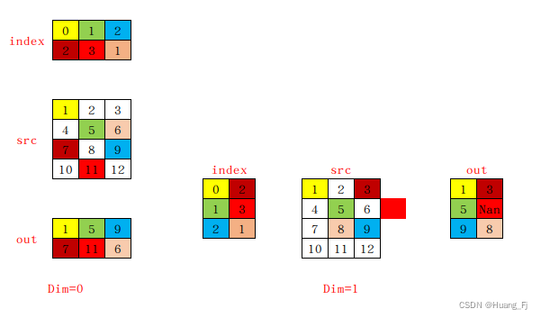官方示例
链接:https://pytorch.org/docs/stable/generated/torch.gather.html
torch.gather(input, dim, index, *, sparse_grad=False, out=None) → Tensor
# 沿由 dim 指定的轴收集input的值,其输出形状与index相同。
- input (Tensor) – the source tensor
- dim (int) – the axis along which to index
- index (LongTensor) – the indices of elements to gather
对于一个3维的tensor,其输出如下:
out[i][j][k] = input[index[i][j][k]][j][k] # if dim == 0
out[i][j][k] = input[i][index[i][j][k]][k] # if dim == 1
out[i][j][k] = input[i][j][index[i][j][k]] # if dim == 2
图解
参考:https://stackoverflow.com/questions/50999977/what-does-the-gather-function-do-in-pytorch-in-layman-terms
torch.gather 通过沿输入维度 dim 从每一行获取值,从输入张量创建一个新张量。 torch.LongTensor 中的值作为索引传递,指定从每个“行”中获取的值。 输出张量的维度与索引张量的维度相同。 以下图片能更清楚地解释它:

label smoothing 中的用法
参考:https://www.pythonfixing.com/2021/11/fixed-label-smoothing-in-pytorch.html
假设GT是
(
0
,
1
,
0
)
(0, 1, 0)
(0,1,0),设label smoothing的系数
α
=
0.2
\alpha=0.2
α=0.2,我们想象中的结果应该是
(
0.1
,
0.8
,
0.1
)
(0.1,0.8,0.1)
(0.1,0.8,0.1),以上标签是上述参考的结果。然而实际上在pytorch和tensorflow中都不是这么实现的,它们俩得到的标签应该是
(
0.8
+
0.2
/
3
,
0.2
/
3
,
0.2
/
3
)
(0.8+0.2/3,0.2/3,0.2/3)
(0.8+0.2/3,0.2/3,0.2/3),再进行交叉熵计算得到结果。
import torch
import torch.nn as nn
# label smoothing
class LabelSmoothingCrossEntropy(nn.Module):
def __init__(self):
super(LabelSmoothingCrossEntropy, self).__init__()
def forward(self, x, target, smoothing=0.1):
confidence = 1. - smoothing
logprobs = x.log_softmax(dim=-1)
print(logprobs.shape)
nll_loss = -logprobs.gather(dim=-1, index=target.unsqueeze(1))
nll_loss = nll_loss.squeeze(1) # cross_entropy loss without mean
smooth_loss = -logprobs.mean(dim=-1)
loss = confidence * nll_loss + smoothing * smooth_loss
return loss.mean()
ce0 = LabelSmoothingCrossEntropy()
ce1 = nn.CrossEntropyLoss(label_smoothing=0.1)
predict = torch.FloatTensor([[0, 0.2, 0.7, 0.1, 0],
[0, 0.9, 0.2, 0.2, 1],
[1, 0.2, 0.7, 0.9, 1]])
label = Variable(torch.LongTensor([2, 1, 0]))
out0 = ce0(predict,target) # tensor(1.3096)
out1 = ce1(predict,target) # tensor(1.3096)
